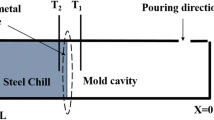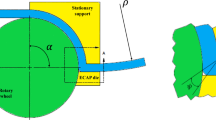Abstract
Metal extrusion process accounts for the production of the majority of industrial and domestic aluminum sections. A major limitation to the success of any extrusion operation is the capability of the particular extrusion press to meet the maximum pressure requirements for that operation. In the present work, the effects of industrial extrusion process parameters and their interactions on the resulting maximum extrusion pressure, of an industrially extruded aluminum alloy, have been studied using a newly devised ANN-based partial modeling technique. Two operating parameters (initial billet temperature and ram speed) and three geometrical parameters (extrusion ratio, profile average thickness, and number of die cavities) were investigated. The main objective for developing this modeling technique is to overcome the limitations of presently available statistical modeling tools, as foreseen by the modeling needs for a complex thermo-mechanical process such as extrusion. The main present limitations are accounting for non-linearity in the process behavior, incorporating interaction effects and a meaningful determination of the highly significant process parameters and/or interactions. These three features have been, collectively, incorporated into the present model by means of combining statistical analysis of variance into ANN and by using a partial sum of squares analysis, which we propose to call the “present factor analysis.” Normal linear regression has been also employed for comparison purposes. According to the present model, maximum extrusion pressure has shown various degree of non-linearity in behavior with respect to the different process parameters and their significant interactions. It has been found that variations in the maximum extrusion pressure are mainly a function of initial billet temperature and its interactions with other process parameters, especially the ram speed. The present ANN-based model has shown superior prediction capabilities compared to the linear model with a marginal overall prediction error value of ±2.5 %.
Similar content being viewed by others
References
Abdul-Jawwad AK, Bashir A (2011) A comprehensive model for predicting profile exit temperature of industrially extruded 6063 aluminum alloy. Mater Manuf Process 26:193–201
Chanada T, Zhou J, Duszczyk J (2001) A comparative study on Iso-speed extrusion and isothermal extrusion of 6061 Al alloy using 3D FEM simulation. J Mater Process Technol 114:145–153
Fang G, Zhou J, Duszczyk J (2008) Effect of pocket design on metal flow through single bearing extrusion dies to produce a thin-walled aluminum profile. J Mater Process Technol 199:91–101
Sheppard T (1999) Temperature changes occurring during extrusion of metals: comparison of bulk, numerical and integral profile predictions with experimental data. Mater Sci Technol 15:459–463
Ozbek I (2007) A study on the re-solution heat treatment of AA 2618 aluminum alloy. Mater Charact 58:312–317
Zhang D, Zheng L, St. John D (2002) Effect of a short solution treatment time on microstructure and mechanical properties of modified Al–7wt.%Si–0.3wt.%Mg alloy. J Light Met 2:27–36
Arif SA, Sheikh A, Qamar S, Al-Fuhaid K (2001) Variation of pressure with ram speed and die profile in hot extrusion of aluminum-6063. Mater Manuf Process 16:701–716
Ebrahimi R, Reihanian M, Moshksar MM (2008) An analytical approach for radial-forward extrusion process. Mater Des 29:1694–1700
Ebrahimi R, Reihanian M, Kanaani M, Moshksar MM (2008) An upper-bound analysis of the tube extrusion process. J Mater Process Technol 199:214–220
Sinha MK, Deb S, Dixit US (2009) Design of a multi-hole extrusion process. Mater Des 30:330–334
Fang G, Zhou J, Duszczyk J (2009) Effect of pocket design on metal flow through single-bearing extrusion dies to produce a thin-walled aluminium profile. J Mater Process Technol 209:3050–3059
Peng Z, Sheppard T (2004) Simulation of multi-hole die extrusion. Mater Sci Eng, A 367:329–342
Fang G, Zhou J, Duszczyk J (2009) FEM simulation of aluminium extrusion through two-hole multi-step pocket dies. J Mater Process Technol 209:1891–1900
Li YY, Bridgwater J (2000) Prediction of extrusion pressure using an artificial neural network. Powder Technol 108:65–73
van de Langkruis J, Lof J, Kool WH, van der Zwaag S, Huetink J (2000) Comparison of experimental AA6063 extrusion trials to 3D numerical simulations, using a general solute-dependent constitutive model. Comput Mater Sci 18:381–392
Kumar S, Vijay P (2007) Die design and experiments for shaped extrusion under cold and hot condition. J Mater Process Technol 190:375–381
Wafi AS, Shatla MN, Abdel-Hamid A (1998) An optimum-curved die profile for the hot forward rod extrusion process. J Mater Process Technol 73:97–107
Karabay S, Yilmaz M, Zeren M (2005) Investigation of extrusion ratio effect on mechanical behaviour of extruded alloy AA-6101 from the billets homogenised-rapid quenched and as-cast conditions. J Mater Process Technol 160:138–147
Zhou L, Duszczyk J (2004) Prediction of temperature evolution during the extrusion of 7075 aluminium alloy at various ram speeds by means of 3D FEM simulation. J Mater Process Technol 146:203–212
Chanda T, Zhou J, Kowalski L, Duszczyk J (1999) 3D FEM simulation of the thermal events during AA 6061 aluminum extrusion. Scr Mater 41:195–202
Tiernan P, Hillery MT, Draganescu B, Gheorghe M (2005) Modelling of cold extrusion with experimental verification. J Mater Process Technol 168:360–366
Ulysse P, Johnson RE (1998) A study of the effect of process variables in unsymmetrical single-hole and multi-hole extrusion process. J Mater Process Technol 73:213–225
Qamar S, Arif A, Sheikh A (2004) A new definition of shape complexity for metal extrusion. J Mater Process Technol 155–156:1734–1739
Sahoo SK (2003) An analysis of plastic flow through polygonal linearly converging dies: as applied to forward metal extrusion. J Mater Process Technol 132:286–292
Bastani AF, Aukrust T, Brandal S (2011) Optimisation of flow balance and isothermal extrusion of aluminium using finite-element simulations. J Mater Process Technol 211:650–667
Shin HW, Kim DW, Kim N (1993) A simplified three-dimensional finite-element analysis of the non-axisymmetric extrusion process. J Mater Process Technol 38:567–587
Montgomery D (2001) Design and analysis of experiments, 5th edn. Wiley, New York
Hambli R (2009) Statistical damage analysis of extrusion processes using finite element method and neural networks simulation. Finite Elem Anal Des 45:640–649
Bishop C (1995) Networks for pattern recognition. Clarendon, Oxford
Lennox B, Montague G, Frith A, Gent C, Bevan V (2001) Industrial applications of neural networks—an investigation. J Process Control 11:497–507
Li HJ, Qi LH, Han HM, Guo LJ (2004) Neural network modeling and optimization of semi-solid extrusion for aluminum matrix composites. J Mater Process Technol 151:126–132
Lucignano C, Montanari R, Tagliaferri V, Ucciardello N (2010) Artificial neural networks to optimize the extrusion of an aluminium alloy. J Intell Manuf 21:569–574
Campana RC, Vieira PC, Plaut RL (2010) Applicability of adaptive neural networks (ANN) in the extrusion of aluminum alloys and in the prediction of hardness and internal defects. Mater Sci Forum 638–642:303–309
Zhou J, Li L, Mo J, Zhou J, Duszczyk J (2010) Prediction of the extrusion load and exit temperature using artificial neural networks based on FEM simulation. Key Eng Mater 424:241–248
Karayel D (2008) Simulation of direct extrusion process and optimal design of technological parameters using FEM and artificial neural network. Key Eng Mater 367:185–192
Barghash M, Santarisi N (2004) Analyzing the effect of training parameters on the performance of the ANN using fractional factorial experimental design. J Intell Manuf 15:635–644
Haykin S (1994) Neural networks a comprehensive foundation. Macmilllan, New Jersey
Yildiz AR (2012) A comparative study of population-based optimization algorithms for turning operations. Inform Sci 210:81–88
Yildiz AR (2009) A novel hybrid immune algorithm for global optimization in design and manufacturing. Robot Cim-Int Manuf 25:261–270
Yildiz AR (2009) An effective hybrid immune-hill climbing optimization approach for solving design and manufacturing optimization problems in industry. J Mater Process Technol 50:224–228
Altan T, Boulger FW (1973) Flow stress of metals and its application in metal forming analysis. J Eng Ind 95:1009–1019
Duan X, Velay X, Sheppard T (2004) Application of finite element method in the hot extrusion of aluminium alloys. Mater Sci Eng A 369:66–75
Author information
Authors and Affiliations
Corresponding author
Rights and permissions
About this article
Cite this article
Abdul Jawwad, A.K., Barghash, M.A. Evaluating the effects of process parameters on maximum extrusion pressure using a new artificial neural network-based (ANN-based) partial-modeling technique. Int J Adv Manuf Technol 68, 2547–2564 (2013). https://doi.org/10.1007/s00170-013-4852-x
Received:
Accepted:
Published:
Issue Date:
DOI: https://doi.org/10.1007/s00170-013-4852-x




